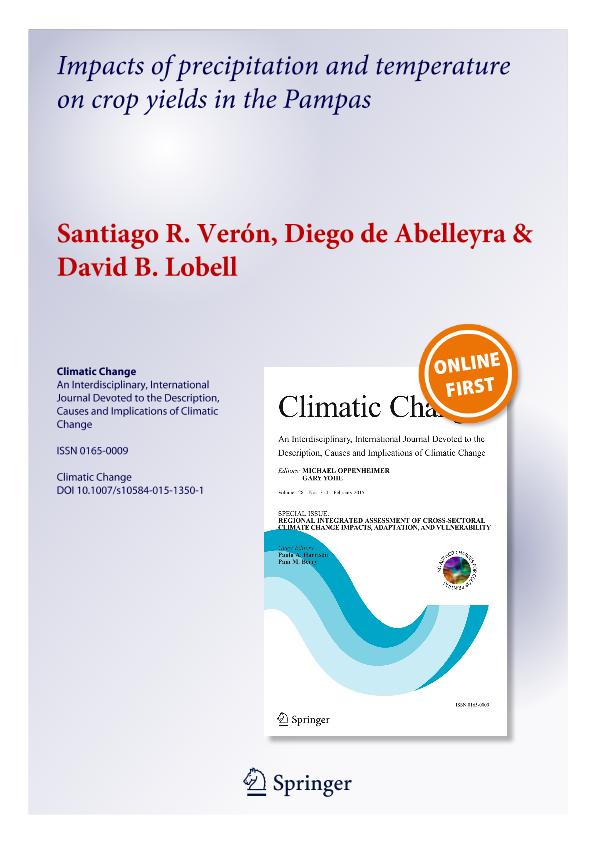Mostrar el registro sencillo del ítem
dc.contributor.author
Verón, Santiago Ramón

dc.contributor.author
de Abelleyra, Diego

dc.contributor.author
Lobell, David B.

dc.date.available
2017-05-18T22:15:15Z
dc.date.issued
2015-05
dc.identifier.citation
Verón, Santiago Ramón; de Abelleyra, Diego; Lobell, David B.; Impacts of precipitation and temperature on crop yields in the Pampas; Springer; Climatic Change; 130; 2; 5-2015; 235-245
dc.identifier.issn
0165-0009
dc.identifier.uri
http://hdl.handle.net/11336/16711
dc.description.abstract
Understanding regional impacts of recent climate trends can help anticipate how further climate change will affect agricultural productivity. We here used panel models to estimate the contribution of growing season precipitation (P), average temperature (T) and diurnal temperature range (DTR) on wheat, maize and soy yield and yield trends between 1971 and 2012 from 33 counties of the Argentine Pampas. A parallel analysis was conducted on a per county basis by adjusting a linear model to the first difference (i.e., subtracting from each value the previous year value) in yield and first difference in weather variables to estimate crop sensitivity to interannual changes in P, T, and DTR. Our results show a relatively small but significant negative impact of climate trends on yield which is consistent with the estimated crop and county specific sensitivity of yield to interannual changes in P, T and DTR and their temporal trends. Median yield loss from climate trends for the 1971−2012 period amounted to 5.4 % of average yields for maize, 5.1 % for wheat, and 2.6 % for soy. Crop yield gains for this time period could have been 15–20 % higher if climate remained without directional changes in the Pampas. On average, crop yield responded more to trends in T and DTR than in P. Translated into economic terms the observed reductions in maize, wheat, and soy yields due to climate trends in the Pampas would equal $1.1 B using 2013 producer prices. These results add to the increasing evidence that climate trends are slowing yield increase.
dc.format
application/pdf
dc.language.iso
eng
dc.publisher
Springer

dc.rights
info:eu-repo/semantics/openAccess
dc.rights.uri
https://creativecommons.org/licenses/by-nc-sa/2.5/ar/
dc.subject
Climate
dc.subject
Tends
dc.subject
Maize
dc.subject
Soy
dc.subject.classification
Agricultura

dc.subject.classification
Agricultura, Silvicultura y Pesca

dc.subject.classification
CIENCIAS AGRÍCOLAS

dc.title
Impacts of precipitation and temperature on crop yields in the Pampas
dc.type
info:eu-repo/semantics/article
dc.type
info:ar-repo/semantics/artículo
dc.type
info:eu-repo/semantics/publishedVersion
dc.date.updated
2017-05-18T21:18:45Z
dc.identifier.eissn
1573-1480
dc.journal.volume
130
dc.journal.number
2
dc.journal.pagination
235-245
dc.journal.pais
Países Bajos

dc.journal.ciudad
Dordrecht
dc.description.fil
Fil: Verón, Santiago Ramón. Instituto Nacional de Tecnología Agropecuaria. Centro de Investigación de Recursos Naturales. Instituto de Clima y Agua; Argentina. Universidad de Buenos Aires. Facultad de Agronomía. Departamento de Métodos Cuantitativos y Sistemas de Información; Argentina. Consejo Nacional de Investigaciones Científicas y Técnicas; Argentina
dc.description.fil
Fil: de Abelleyra, Diego. Instituto Nacional de Tecnología Agropecuaria. Centro de Investigación de Recursos Naturales. Instituto de Clima y Agua; Argentina
dc.description.fil
Fil: Lobell, David B.. University Of Stanford; Estados Unidos
dc.journal.title
Climatic Change

dc.relation.alternativeid
info:eu-repo/semantics/altIdentifier/doi/http://dx.doi.org/10.1007/s10584-015-1350-1
dc.relation.alternativeid
info:eu-repo/semantics/altIdentifier/url/https://link.springer.com/article/10.1007%2Fs10584-015-1350-1
Archivos asociados
